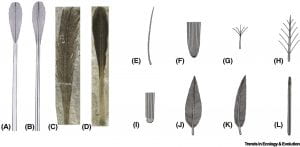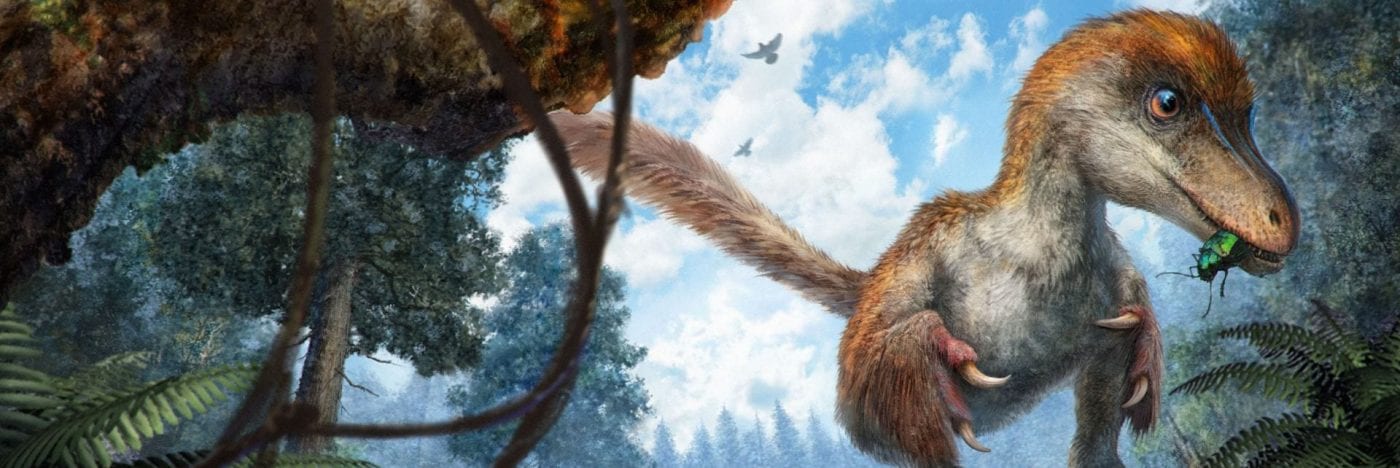Bird feathers
Modern birds possess seven types of feathers, which can be described as filaments or pennae; all of them are fixed by a calamus in the skin. The filaments include three types – bristles (stiff rachis, protect eyes and face), filoplumes (stiff rachis, bearing a few barbs at its apex, with a sensory function), and down feathers (very short rachis bearing about ten to thirty barbs, deprived of hooklets, mainly for insulating the body).
 [Left] The seven types of feathers seen in modern birds. Image courtesy of the Cornell Bird Academy.
[Left] The seven types of feathers seen in modern birds. Image courtesy of the Cornell Bird Academy.
The four types of pennaceous feathers all have a central axis, the quill-like rachis, and laterally branching barbs. These types are semiplumes (barbs branch from central rachis, but no hooks on the barbules, so barbs are fluffy and insulating), contour feathers (central rachis, barbs have hooklets, and provide streamlined cover to the body), tail feathers (or rectrices, like contour feathers, and can fan out for flight control or display), and wing feathers (or remiges, like the contour and tail feathers, with interlocking barbules, and form a strong wing structure for powered flight).
Dinosaur feathers
When feathers were first identified in dinosaur specimens from China, their morphologies matched the feather types known from modern birds . However, as more specimens were examined, it became clear that some of the fossil feather morphologies could not be matched in living birds. For example, the ribbon-like feathers of the oviraptorosaur theropod dinosaur Similicaudipteryx from the Early Cretaceous of China (Xu et al. 2010) comprised an elongate ribbon-like rachis with a pennaceous tip, with neatly organised, radiating barbs (Figure below, A–D,L). Similar ribbon feathers are known in some basal birds, especially in the tail, and may have mainly operated as display structures that could be erected and rattled.
The simple bristle type of feather (Figure below, E), while widespread among theropod dinosaurs, was lost in most birds, as were the brush feather (Figure below, I) and ribbon-like feather (Figure below, L). The reasons for these losses are uncertain.
More widely among dinosaurs, other kinds of bristle and multiply branching feather have been noted. For example, the ornithischian Psittacosaurus sports a ‘fence’ of ~100 cylindrical bristles along the midline of its tail, each up to 160 mm long (Mayr et al. 2016). The heterodontosaurid ornithischian Tianyulong also had bristles along its back (Zheng et al. 2009).
 [Right] Diversity of Fossil Feathers. Some dinosaurs had feathers not seen in modern birds. For example, some theropods and extinct birds had ribbon-like feathers with expanded tips, seen in the oviraptorosaurian theropod Similicaudipteryx (A), an unnamed maniraptoran (B), an enantiornithine bird (C), and a confuciusornithid bird (D). The diversity of feather types seen in theropod dinosaurs (E–L) includes some morphologies (E, I, and L) not seen in modern birds. Images courtesy Xu Xing.
[Right] Diversity of Fossil Feathers. Some dinosaurs had feathers not seen in modern birds. For example, some theropods and extinct birds had ribbon-like feathers with expanded tips, seen in the oviraptorosaurian theropod Similicaudipteryx (A), an unnamed maniraptoran (B), an enantiornithine bird (C), and a confuciusornithid bird (D). The diversity of feather types seen in theropod dinosaurs (E–L) includes some morphologies (E, I, and L) not seen in modern birds. Images courtesy Xu Xing.
Most dramatically, the Middle Jurassic ornithopod Kulindadromeus from Siberia shows a great range of feathers and scales of all sizes, including monofilaments around the head and thorax. The most complex feather type present comprises a basal plate from which five to seven slender filaments emerge. The basal plates are arranged in regular patterns over the surface of the skin, and the filaments run backwards (Figure below, A). The scales were unexpectedly large and widely distributed: rhomboid scales in neat arrays up and down the legs, and broad scales above and below the tail. The describers suggested that these were not ‘primary’ scales, meaning inherited unchanged from ancestors, but some at least were likely secondarily derived from feathers, just as chicken scales and pangolin scales are said to be secondary.
Even the pterosaurs, cousins of the dinosaurs, show a diversity of feather types, including E, F, and G above (Yang et al. 2019).
References
- Benton , M.J., Dhouailly, D., Jiang, B.Y., and McNamara, M. 2019. The early origin of feathers. Trends in Ecology & Evolution online before print (doi: 10.1016/j.tree.2019.04.018) ). pdf.
- Mayr, G., Pittman, M., Saitta, E., Kaye, T. G. and Vinther, J. 2016. Structure and homology of Psitta- cosaurus tail bristles. Palaeontology 59, 793–802.
- Xu, X. et al. 2010. Exceptional dinosaur fossils show ontogenetic development of early feathers. Nature 464, 1338-1341.
- Yang, Z.X., Jiang, B.Y., McNamara, M.E., Kearns, S.L., Pittman, M., Kaye, T.G., Orr, P.J., Xu, X., and Benton, M.J. 2019. Pterosaur integumentary structure with complex feather-like branching. Nature Ecology & Evolution 3, 24–30. pdf. Supplementary file.
- Zheng, X.-T., You, H.-L., Xu, X. and Dong, Z.-M. 2009. An Early Cretaceous heterodontosaurid dinosaur with filamentous integumentary structures. Nature 458, 333–336.

